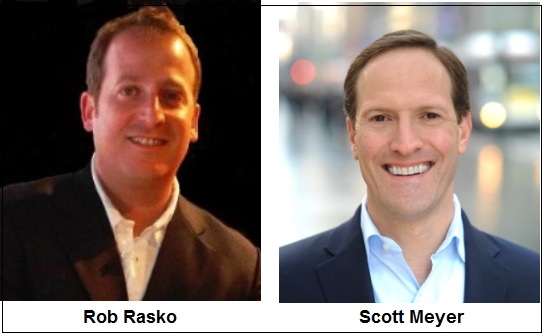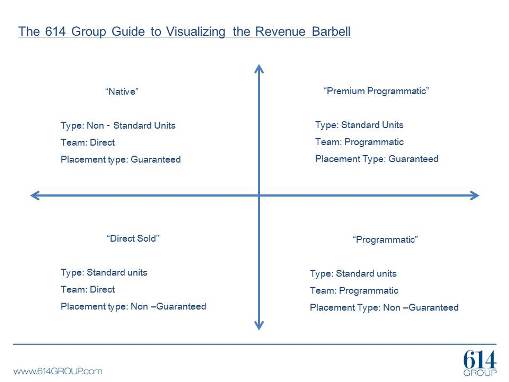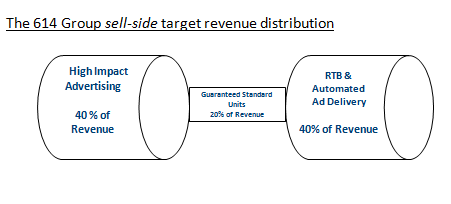Five Selling Points to Optimize Publishers' Revenue Strategy -- Scott Meyer and Rob Rasko

This column was written by Scott Meyer, CEO, Evidon and Rob Rasko, Founder & Managing Partner, The 614 Group
Recently, AOL CEO Tim Armstrong pointed to his company’s “barbell advertising strategy” as proof all will soon be well with the publisher. By distributing eggs into many baskets, AOL was learning to weather the tidal ebbs and flows of digital advertising.
Wait, aren’t barbells for fitness clubs and muscle-building? Yes, but it’s also a term that describes publishers who want to build tone and increase strength for content monetization efforts.
When you hear “barbell strategy” today, it’s about the realization that both direct (“native”) and in-direct (“programmatic”) types of advertising solutions are required to power inventory monetization strategies of premium publishers. This is not just about selling ads; it’s also about properly powering experiences which advertisers’ desire and delivering access to inventory in line with where the market is heading.
If you aren’t following the breadcrumbs, your barbell strategy can turn into a dumbbell strategy.
Digital Barbells: Lunges and Lessons
Most publishers sell their inventory in the following four ways:

But are you managing your resources to where the money is flowing? Here is where we believe the market is heading. Are you ready for this inevitable future?

In order to be ready, we suggest focusing on five key areas:
#1: Compensation Structures & Team Leadership
This is really about “back-to-basics.” Focus on long-term thinking. Don’t discount the courage of your convictions. Publishers can increase revenue by sticking to their guns. Don’t let compensation issues be a pejorative. Nor should acceptance of programmatic sales models translate into job loss.
A barbell strategy is as much about training as about commission splits. Programmatic selling should positively affect sales rep commissions and the corporate environment in general. If the goal of growing company revenue and CPM is affected by both sides of the barbell, then sales colleagues need to be a part of that solution. After all, agencies and marketers see you as one entity.
#2: Automated & Integrated Internal Business Practices
Control only comes from visibility. That starts with giving both ends of the barbell an efficient system for sharing data. This is especially true in forecasting, rate sheets, pipelines and even cancelations. The direct sales team can’t sell successfully if they don’t have a reliable way of assessing inventory availability.
This visibility extends into knowing what code is on the website, so only the partners you want have access to your audience data. Without adapting quickly in a data-driven marketplace, stakeholders can kiss direct ad dollars goodbye.
#3: Proper Technology Stack
Publishers are desperately seeking the holy grail of a totally integrated tech stack. Because the number of boxes in the infamous ad tech industry Kawaja chart has not metastasized in some time, this represents a long-anticipated normalization in the rate of change in the dynamics of our ecosystem. That means it’s time to feel comfortable about making longer term, strategic and smart investments into technology, people and process.
#4: Constant Vendor Evaluation and Competitive Intelligence
With a tech stack in place, your barbell strategy won’t succeed if you “set it and forget it.” It requires constant diligence, as the performance of networks and tech vendors changes all the time. Does the tag load so slowly it disrupts your user experience? Does it spawn 20 other vendor tags with access to your audience data? How important are you to each of your tech vendors? Without hard data on how revenue strategies are really working, it’s hard to make tough decisions. Proper business intelligence is a game-changer.
#5: Controlling Access to Supply
Nothing speaks to a publisher’s fears of programmatic like access to supply. Direct sales teams spend months and years nurturing relationships with brands and agencies, so naturally no one wants clients buying impressions at discounted CPMs from ad exchanges or ad networks. How you differentiate your direct offering from what the agency can buy programmatically is key. Do you know the top ad networks collecting data on your audience? Do you know how much of those networks’ inventory your site represents? Until you do, the programmatic world will have an easy time pulling direct brand dollars away from your site.
AOL is right: The barbell strategy is an excellent way for premium publishers to address programmatic and direct advertising. It will help meet the increasing demand your current advertisers have for both methodologies. In fact, you’ll strengthen your relationship by offering one convenient location (you) to purchase their native and programmatically-sold inventory.
Whether or not this approach will earn you more money is not the issue. When you put a lot of time and consideration into it, the profit is inevitable. And that’s a big weight lifted off your shoulders.
CEO Scott Meyer created Evidon (formerly Better Advertising) while an Entrepreneur in Residence at Warburg Pincus LLC, the global private equity firm that is supporting the company. From 2005-2008, Scott was President and CEO of About.com, a part of The New York Times Company. He spent eight years with The New York Times Company in a number of senior management roles.
As a thought leader in the digital marketing industry, The 614 Group Founder and Managing Partner Rob Rasko has focused on the major issues which have shaped the industry specifically with an expertise in brand safety. A distinguished leader in the Ad Tech industry Rob serves currently as the Program Director of IAB Quality Assurance Guidelines (QAG). The 614 Group is global digital solutions firm with partners located in New York, Seattle, London and Berlin.
Check us out on Facebook at MediaBizBloggers.com
Follow our Twitter updates @MediaBizBlogger
The opinions and points of view expressed in this commentary are exclusively the views of the author and do not necessarily represent the views of MediaBizBloggers.com management or associated bloggers. MediaBizBloggers is an open thought leadership platform and readers may share their comments and opinions in response to all commentaries.


